George Caleb Bingham
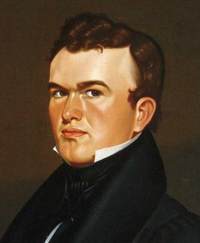
George Caleb Bingham Biography
George Bingham, though famous as a Missouri artist, was actually born in the state of Virginia on March 20, 1811, on a large farm encompassing eleven hundred and eighty acres, which also included the famous Grand Caverns, then known as Weir’s Cave. The estate belonged to his father, Henry Vest Bingham, and his mother, Mary Bingham, nee Amend. What little is known of them indicates that they were fairly well-to-do and both well-educated. George was the second of seven children.
When George was eight, his family moved to Franklin, Missouri, after his father lost money in a bad investment and decided to try his fortune in the West. However, George’s artistic streak became evident well before that time, at the very early age of four, when he attempted to emulate a rough sketch his father had drawn on a piece of slate. He was soon able to accurately replicate any such engravings. Though he lacked access to actual painting supplies during this period, he proved to be quite resourceful in his ability to improvise, using everything from axle grease to, allegedly, his own blood as substitutes.
In Franklin, the family set up a tobacco factory which became a lucrative business that helped them reclaim a certain amount of their former prosperity. At the same time, they invested in a large farm of over a hundred and fifty acres, and by 1821 they owned a tavern in the public square of Franklin.
Unfortunately, in 1823, George’s father died, leaving behind his wife and children, the eldest of whom, Henry, was fourteen. It is unclear whether the tobacco factory and tavern shut down outright or whether Bingham’s family was forced to sell their share in them, but either way the widow and her children ended up with nothing but the farm in their possession and had to work hard for their living. Mary Bingham’s high level of education came in useful, and she was able to tutor not only her own children but eventually opened a private school for young women. During this time, George helped his elder brother tend to the farm. When the weather didn’t allow for work in the fields, they took whatever other jobs they could find. Likely due to experience acquired in the tobacco factory, George often found work rolling cigars.
When he was sixteen, he was offered an apprenticeship to a cabinet-maker in the neighboring town of Boonville and his mother was quick to send him away, deeming the job less taxing than the daily farm chores. Bingham turned out to be very adept at woodcarving and quickly outshone his fellow apprentices. However, although the art came easy and the profession allowed him to earn substantial money with which to support his family, his heart was set on painting, which he dabbled in at every opportunity. At this time, Bingham also began studying law, which he hoped to someday turn into a profitable career, and theology.
Thus, when his apprenticeship was finally concluded, he was uncertain about which path to choose. It was at this point that he met a traveling artist by the name of Chester Harding, who, upon studying Bingham’s amateur works, persuaded him to pursue an artistic career and gave him some of his first lessons in professional painting.
Surprisingly, perhaps as a result of the small size of the community in which he lived and the lack of other artists in the area, Bingham was hardly finished with his lessons with Harding before he began receiving commissions, most of them portraits. According to some accounts, the young artist was not very proficient with his choice of colors, but despite this his patrons were pleased with his work, often remarking on how accurate the portraits were and how quickly he worked. Indeed, by all accounts, he took to painting with the same patience and conviction he’d displayed with all his previous professions, allegedly painting as many as twenty-five pictures in less than a month. Very soon, he had established a very large client base.
In 1834 Bingham visited Columbia, Missouri, where he found some of his more renowned patrons, among them Colonel Caleb S. Stone (1834), Judge Waren Woodson (1834) and Hon. Josiah Wilson (1834) and most importantly, Major James S. Rollins (1834). Rollins, a young lawyer, and Bingham became fast friends. The lawyer was very impressed with Bingham’s work and agreed to lend him enough money to travel to St. Louis to study painting. This was something Bingham had been hoping to do for a while, even attempting to reach St. Louis by foot on one occasion, but that journey had been cut short by an untimely case of the measles.
He arrived in St. Louis sometime in 1836. It is presumed that he took this opportunity to study under local artists, however none of his mentors of this time period are known. His perpetual state of poverty may have even prevented him from receiving much training, and it’s quite likely that much of his time was spent painting portraits for various patrons to pay for his room and board. He returned to Boonville later that year, where he married Miss Elizabeth Hutchinson and they both settled in a small brick house he built with his own hands.
For the first few months of the following year Bingham was preoccupied with more portraiture, with patrons including Dr. Anthony W. Rollins (1837) and his wife Mrs. Anthony W. Rollins (1837), Mr. Lamme (1837) and his wife Mrs. David Steele Lamme together with their little son (1837), Hon. Roger North Todd (1837) and General Richard Gentry (1837). However, perhaps his most famous portrait from this time was a miniature of Columbia College’s first president, Mr. Thomas Miller (1837). It is Bingham’s smallest known painting.
Later that same year, the young artist traveled to Philadelphia to study art at the Pennsylvania Academy of Fine Arts, which was then the oldest and most prosperous art institute in the country. How long exactly Bingham stayed at the academy is a matter of debate among historians, with estimates ranging from three months to three years. Several portraits of residents from his county, however, the earliest of which, the portrait of Mrs. Thomas Shackelford, is dated 1839, suggest that he returned home within two years’...
George Caleb Bingham 70 Most Important Paintings and Artworks
- Dr. John Sappington.
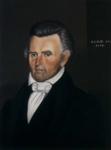
1834. Oil on canvas. 27 x 21 3/4". Missouri State Park Board, Jefferson City, MO, USA.
- Mrs. John Sappington (Jane Breathitt).
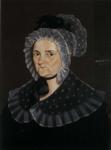
1834. Oil on canvas. 27 x 21 3/4". Missouri State Park Board, Jefferson City, MO, USA.
- Self-Portait.
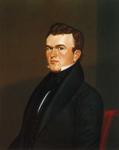
1834-35. Oil on canvas. 71.1 x 57.1 cm. Saint Louis Art Museum, St. Louis, MO, USA.
- Mrs. David Steele Lamme And Son William Wirt.
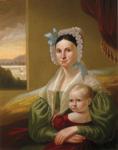
1837. Oil on canvas. 89.5 x 71 cm. Private collection.
- General Richard Gentry.
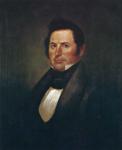
1837. Oil on canvas. 27 1/2" x 22 1/2". Private collection.
- Leonidas Wetmore.
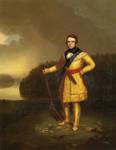
1839-40. Oil on canvas. 152.4 x 101 cm. Private collection.
- Miss Anna Rives Heath.
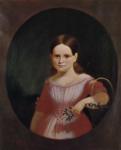
1841. Oil on canvas. 30" x 24 1/2". Private collection.
- The Dull Story.
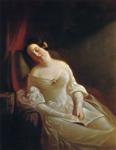
1843-44. Oil on canvas. 50 3/8 x 38 7/8". Private collection.
- The Mill Boy: The Boonville Juvenile Clay Club Banner.
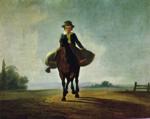
1844. Oil on canvas. 37 1/4 x 40 1/2". Private collection.
- John Cummings Edwards.
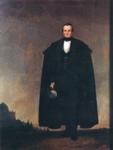
1844. Oil on canvas. 35 1/2 x 28 1/2. Missouri Historical Society, St. Louis, MO, USA.
- John Quincy Adams.
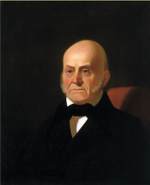
c. 1844. Oil on canvas. National Portrait Gallery, Washington, DC, USA. Read Note.
- The Concealed Enemy.
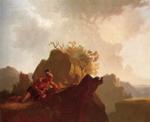
1845. Oil on canvas. 74.29 x 92.71. Stark Museum of Art, Orange, TX, USA.
- Cottage Scenery.
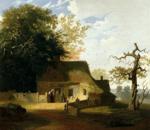
1845. Oil on canvas. 73.6 x 91.4 cm. The Corcoran Gallery of Art, Washington, DC, USA.
- Landscape: Rural Scenery.
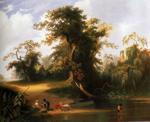
1845. Oil on canvas. 73.6 x 91.4. Private collection.
- Family Life On The Frontier.
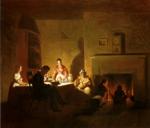
Before 1845. Oil on canvas. 61.6 x 76.2 cm. Private collection.
- Fur Traders Descending The Missouri.
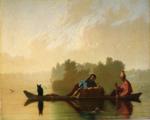
1845. Oil on canvas. 73.66 x 92.71 cm. The Metropolitan Museum of Art, New York, USA.
- Fur Traders Descending The Missouri. Detail.
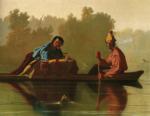
1845. Oil on canvas. 73.66 x 92.71 cm. The Metropolitan Museum of Art, New York, USA.
- Landscape With Cattle.
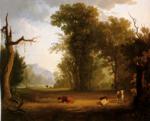
1846. Oil on canvas. 96.5 x 121 cm. Saint Louis Art Museum, St. Louis, MO, USA.
- The Jolly Flatboatmen.
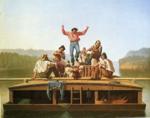
1846. Oil on canvas. 96.63 x 123.19 cm. Private collection.
- The Jolly Flatboatmen. Detail.
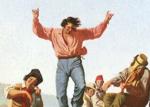
1846. Oil on canvas. 96.63 x 123.19 cm. Private collection.
George Caleb Bingham Bibliography
George Caleb Bingham: Missouri's Famed Painter and Forgotten Poilitician by Paul Nagel. University of Missouri, 2005
The Painting and Politics of George Caleb Bingham by Nancy Rash. Yale University Press, 1991.
The Paintings of George Caleb Bingham: A Catalogue Raisonne by E. Maurice Bloch. University of Missouri Press, 1986.
The Drawings of George Caleb Bingham, with aCatalogue Raisonne by E. Maurice Bloch. University of Missouri Press, 1975.